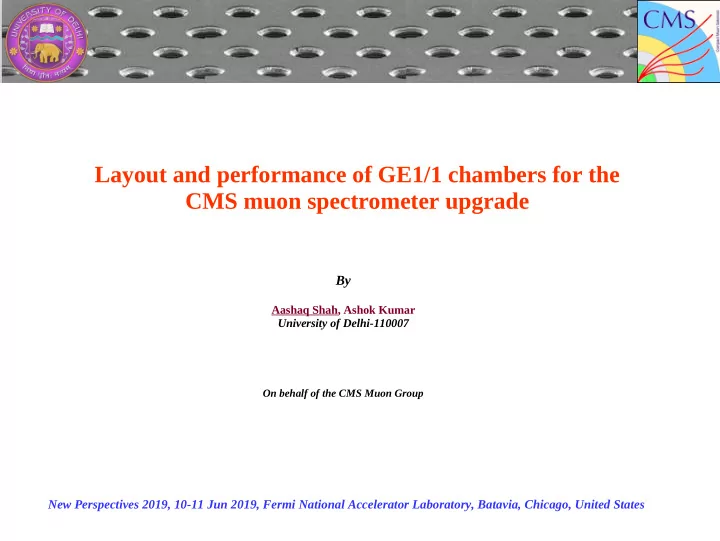

Layout and performance of GE1/1 chambers for the CMS muon spectrometer upgrade By Aashaq Shah, Ashok Kumar University of Delhi-110007 On behalf of the CMS Muon Group New Perspectives 2019, 10-11 Jun 2019, Fermi National Accelerator Laboratory, Batavia, Chicago, United States
Introduction Experiments to face high rate after the LHC upgrade Problems CMS muon system could face due to increase in background rate – Increase in the level-1 muon trigger rates in the forward region |η| > 1.6 – May accelerate the aging of the current CSC system and could lead the loss of performance Phase II of CMS experiment requires the upgrade of forward muon endcap to maintain high level of performance Muon detector requirements Detector should be able to cope up with high rate (~100 kHz/cm 2 ) Good position (~100 m m or better) and temporal resolution (~20 ns or even better) Should be radiation resistant Solution proposed by CMS collaboration Technology going to be used “GEM” Provide fast triggering and precise tracking Improve muon trigger 1
Gas Electron Multiplier (GEM) C o n c e p t o f G E M i n t r o d u c e d b y F a b i o S a u l i * Electron Microscope view of a GEM T h i n d o u b l e - s i d e d me t a l - c o a t e d p o l y me r f o i l c h e mi c a l l y p i e r c e d b y a h i g h d e n s i t y o f h o l e s T y p i c a l p a r a me t e r s : K a p t o n me t a l c o a t e d ~ 5 0 μ m P i t c h ~ 1 4 0 μ m C u t h i c k n e s s ~ 5 μ m H o l e d e n s i t y ~ 5 0 t o 1 0 0 mm - 2 2 * F. Sauli, Nucl.Instrum.Meth. A386 (1997) 531-534
CMS GE1/1 Chamber design An arrangement of three cascaded GEM foils allows to attain gain ~10 5 Fields ● Drift field ~2.5 kV/cm ● Induction field ~ 5kV/cm ● Transfer fields ~ 3kV/cm ● Arcoss hole ~80-100kV/cm Details: Evolution of GE1/1 detector’s since 2010 from – Aashaq Shah et al., CMS DN-2015/020 3 generation-I to X (2018) – CMS Muon Collaboration , Nucl. Inst. Meth. A 918 (2019) 67
GE1/1 project description GE1/1 chambers to cover 1.6 < |η| < 2.4 A total of 144 chambers needed Mechanical constraints, two versions of chambers, the long GE1/1-L with a length of 128.5 cm and the short GE1/1-S of 113.5 cm 4
GE1/1 Performance: Gain Measurements The effective gas gain is measured by exposing the detector to an X-ray source CMS operating gas mixture Ar/CO 2 (70/30) Comparing primary current in the drift gap with the amplified output current induced on the readout board Design of the setup used for gain measurements with X-rays and the GE1/1 detector inside the 5 copper chamber
Beam tests: Efficiency and timing ● CERN’s H4 and H6 beam facilities at Prevessin have been used ● RD51 Tracking Telescope consisting three scintillators S1, S2 and S3, three 10 cm × 10 cm GEM trackers ● Muon beams of 150 GeV energy ● 98% efficiency is estimated at a gain of 2 x 10 4 ● Timing resolution upto ~ 7 ns 6
Discharge Probability Discharges initiate when the charge exceeds Raether limit and could damage the chamber Gain is set to extremely high value ranging from 4 to 6 × 10 5 and the detector is irradiated by densely ionizing -particles from 241 Am source The actual discharge probability is calculated by extrapolation to CMS region Alpha particles from the 241 Am source, produces nearly hundred times more primaries than a MIP and hence, the discharge probability is divided by this factor and is observed to be less than 10 -11 for standard CMS operating conditions Note: Discharges were only induced and No discharges are expected in CMS 7
Performance Summary All-in-one plot The new data points have been calculated using the technique of interpolation Master plot of GE1/1 detectors showing the gain, discharge probability, efficiency and timing resolution for Ar/CO 2 The shaded region is the recommended operational region of the chambers during their use in CMS 8
Current status of GE1/1 project The CMS Collaboration proposed the use of GEM in the muon endcap in 2009 After, several years of R&D, various generations of GE1/1 chambers were produced with generation-X in 2017 as the latest and final Ten such chambers have been installed inside the CMS experiment during 2017 EYETS and are providing full operational experiance All the 144 GE1/1 chambers have been produced and validated (Dec. 2018) and will be installed in CMS A photograph taken in December 2018 showing some experiment during LS2 (2019-2020) of the large size GE1/1 chambers that have been constructed and stored in racks at CERN Prevessin building 904. 9
Integration of GE1/1 chambers with the CMS is ongoing Project on schedule Thank You! 10
Recommend
More recommend